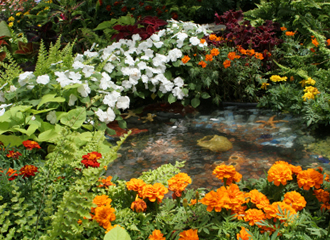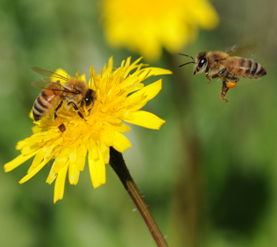There are some great gardening tips in this article from someone who obviously knows what he is talking about. They will save you time, money and temper! I'm not sure I approve of his method of deterring cats from using your garden as a toilet but otherwise, take his gardening tips onboard.
I've amassed these 10 tips over my many years of being an avid amateur gardener, and nature-loving enthusiast, from old gardeners, neighbours, friends and my own tried and tested methods. I'm no expert and would never claim to be one, I only pass on a small part of my accumulated knowledge in the hope of helping others enjoy the most rewarding of pastimes "Amateur Gardening".
- To prevent animals from digging up and eating your spring bulbs, you should have first, wrapped them in a thin layer of steel wool. It does no harm to the bulbs, as its shoot will push right through it.
- Washing up liquid makes a great insecticidal soap when you mix it with water. Take 1 to 3 tablespoons of washing up liquid and mix it into 4 litres of water, add a tablespoon of vinegar too, put it in a spray bottle and mist spray the entire plant. Small left over soap bars, you remember the ones that clutter the soap tray in the bathroom, and no one likes to use, can be utilized also and easily dissolved using warm or boiling water. Of course always remember to let it cool before applying to your plants. Soapy dish or bath water can also be collected and used effectively.
- Cut all flower stems at an angle, as it creates a larger surface area for the flowers to draw up more water and you must remember to put your flowers into water immediately. When I cut long stemmed flowers I take a deep pale almost full to the brim with water which was stood in my glasshouse or shed overnight just for this purpose. If you don't then tiny air pockets will form in the stems and cause the flowers to droop. Oh yes and don't forget to drop an aspirin in your vase with the water, your flowers will love you for it and repay you by staying fresh looking for longer. A small piece of an Alka-Seltzer tablet or a part spoon of liver salts, once the fizzing has stopped are good alternatives to aspirin. Don't put long stemmed flowers in a small vase, and visa versa, for small stemmed ones. Always choose the appropriate vase and your cut flowers will certainly last a little longer, provided you maintain the correct water level. Last but not least, never ever use water straight from your tap for your vase of flowers, always put water in your vases the night before and stand them on a windowsill to gain room temperature, as tap water is very cold and causes those little air bubbles to form.
- If you didn't plant your trees and shrubs late last autumn, to get well established before the onset of winter, then it's nearing that time of year in temperate zones, when the ground is free from hard frosts. They can be planted out now or as soon as they become available at garden centres and nurseries. Always choose the ones with the freshest or plumpest buds, as these are raring to get growing. A good handful of bone meal or other general-purpose plant food, even the pellet form of chicken manure dug well in the bottom of the hole will help feed your new addition to your garden. Large trees will benefit from the addition of a length of garden hose being buried alongside their roots to help watering in long dry spells.Bonemeal is best as it is a slow release source of nitrogen - trees are a long term project and the bonemeal fertiliser will last over a year. Mix well into the surrounding soil to encourage root growth.
- Use old bubble wrap to line your pots and containers, it will help warm the compost and prevent late frosts from damaging delicate new roots.
- When planting up your fresh spring hanging baskets why not use your old knitwear or newspapers for a no cost basket liner, this will save you plenty, and the money saved can go towards better quality compost and plants. Don't throw away the remnants of last summers baskets; either dig it into your garden or at the very least put it in your compost bin.
- When giving your garden hedges that spring prune, get nice neat level edges and flat tops by fastening a length of rope to two points across it. Or push broom handles into the hedge at each end and tie your line to them. An old washing line or strong garden twine are ideal, remember not to cut through your line. Although not 100% accurate it will certainly help achieve a better-looking hedge.
- So now the path has over wintered, and the mosses, lichen's and of course the weeds have all taken over. Salted Boiling water and a good stiff broom will do the trick. It may need to be repeated, but will not damage surrounding soil like commercial products can, and is the safest where pets are concerned.
- We all love our own pets, but we simply hate it when that old cat from down the way decides to use your garden and freshly dug flowerbeds as a toilet. Now I've tried just about everything in the book apart from a shredder LOL and I've still yet to find a really good solution to this problem, as most only seem to work for only a short time. Please don't say get a dog, frankly my dog is fast asleep just like me when our neighbourhood cats come calling. The closest I've come to a deterrent is rose thorns on your flowerbeds, the cats simply hate them as its like walking on glass and as any gardener knows who has ever had rose thorns in his/her fingers that really hurt and are difficult to get out. It's often easiest to grow lots of plants that cats don't likeClear plastic bottles filled with water often deter cats for some reason - perhaps their distorted reflection scares them.
- Now dogs are a lot different, because of their acute sense of smell, old perfume, or the ones given you for Christmas, you know the ones that you always give away as presents to those you don't really like, well use them in your garden instead. Even aftershave will work wonders. Cayenne, White or Black Pepper powders can also help but are easily washed away by rain.
http://www.allotment.org.uk/













